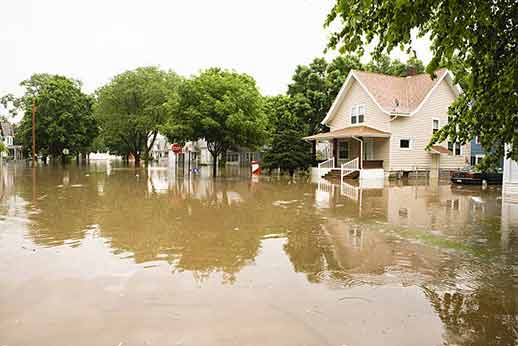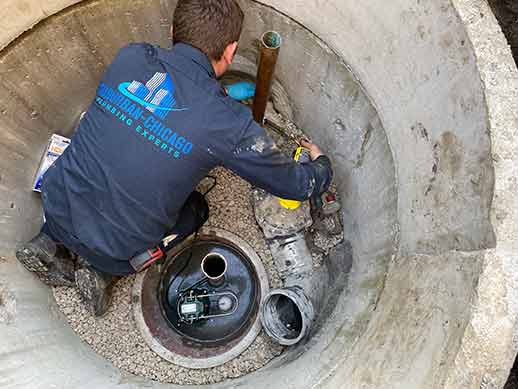
Backflow valves are essential components in plumbing systems designed to prevent the reverse flow of water. In the context of flood prevention, these valves play a critical role in safeguarding homes and public infrastructure from water damage. Below we get into the significance of backflow valves, particularly in Illinois, where flooding is a common concern.
Understanding Backflow and Its Consequences
Backflow occurs when water flows in the opposite direction of its intended path, potentially contaminating clean water supplies with pollutants from various sources. This can happen due to changes in pressure within the plumbing system, often caused by events such as heavy rainfall, pipe bursts, or sudden drops in water pressure. The consequences of backflow can be severe, leading to health hazards, property damage, and costly repairs.
The Mechanism of Backflow Valves
Backflow valves, also known as check valves or non-return valves, are designed to allow water to flow in one direction only. They automatically close when water attempts to flow backward, thus preventing contamination and flooding. These valves are typically installed at critical points in the plumbing system, such as at the main water supply line or near appliances that are prone to backflow.
Flooding in Illinois: A Recurring Challenge
Illinois is no stranger to flooding, with its diverse geography and climate contributing to frequent flood events. From the Mississippi River to the Great Lakes, the state experiences various types of flooding, including riverine, flash, and urban flooding. These events can cause significant damage to homes, businesses, and public infrastructure, highlighting the need for effective flood prevention measures.
The Role of Backflow Valves in Flood Prevention
Backflow valves are a crucial component of flood prevention strategies in Illinois. By preventing the reverse flow of water, these valves help protect properties from water damage during flood events. They are particularly important in areas with combined sewer systems, where heavy rainfall can overwhelm the system and cause sewage to backflow into homes and streets.
Protecting Homes with Backflow Valves
For homeowners in Illinois, installing backflow valves is a proactive step towards safeguarding their properties from flooding. These valves can be installed in various locations, such as basement drains, sump pumps, and main sewer lines. By preventing water from flowing backward into the home, backflow valves help reduce the risk of water damage and the associated repair costs.

By preventing water from flowing backward into the home, backflow valves help reduce the risk of water damage and the associated repair costs.
Backflow Valves in Public Infrastructure
In addition to protecting individual homes, backflow valves play a vital role in safeguarding public infrastructure. Municipalities in Illinois use these valves to protect water treatment plants, sewage systems, and other critical facilities from backflow contamination. This helps ensure the safety and reliability of public water supplies and sewage systems, even during flood events.
Regulations and Standards for Backflow Prevention
To ensure the effectiveness of backflow prevention measures, Illinois has established regulations and standards for the installation and maintenance of backflow valves. These regulations are designed to protect public health and safety by preventing water contamination and flooding. Homeowners and businesses are required to comply with these standards, which include regular inspections and testing of backflow prevention devices.
Choosing the Right Backflow Valve for Your Needs
There are various types of backflow valves available, each suited for different applications and plumbing systems. Some common types include check valves, reduced pressure zone (RPZ) valves, and double check valves. When choosing a backflow valve, it is important to consider factors such as the type of plumbing system, the level of protection required, and local regulations. Speaking with a professional plumber in Chicagoland can help ensure that the right valve is selected and properly installed.
Maintenance and Testing of Backflow Valves
Regular maintenance and testing are essential to ensure the continued effectiveness of backflow valves. Over time, these valves can become worn or damaged, compromising their ability to prevent backflow. In Illinois, regulations require periodic testing of backflow prevention devices by certified professionals. This helps identify any issues and ensures that the valves are functioning correctly.
Case Studies: Successful Implementation of Backflow Valves
Several case studies highlight the successful implementation of backflow valves in Illinois. For example, in the city of Chicago, the installation of backflow prevention devices in residential and commercial properties has significantly reduced the incidence of flooding and water contamination. Similarly, in smaller towns and rural areas, backflow valves have proven to be an effective measure in protecting homes and public infrastructure from flood damage.
Challenges and Considerations in Backflow Prevention
While backflow valves are an essential component of flood prevention, there are several challenges and considerations to keep in mind. These include the initial cost of installation, the need for regular maintenance and testing, and the potential for valve failure if not properly maintained. Additionally, public awareness and education about the importance of backflow prevention are crucial to ensuring widespread adoption of these measures.
Future Trends in Backflow Prevention
As technology advances, new and improved backflow prevention devices are being developed. These include smart valves that can be monitored and controlled remotely, providing real-time data on the status of the plumbing system. Such innovations hold promise for enhancing the effectiveness of backflow prevention measures and further reducing the risk of flooding and water contamination.
Summing It Up
In conclusion, backflow valves play a critical role in preventing flooding and protecting homes and public infrastructure in Illinois. By preventing the reverse flow of water, these valves help mitigate the risk of water damage and contamination, ensuring the safety and well-being of residents. As flooding continues to be a recurring challenge in the state, the importance of backflow prevention measures cannot be overstated. Homeowners, businesses, and municipalities must prioritize the installation and maintenance of backflow valves to safeguard against the devastating effects of flooding.

